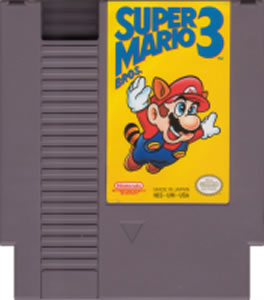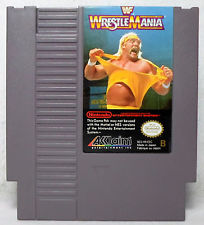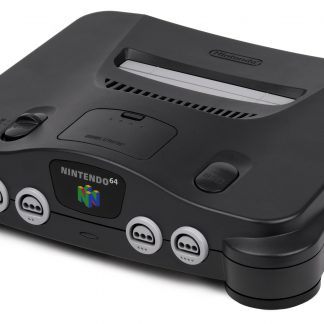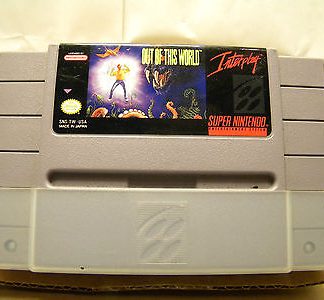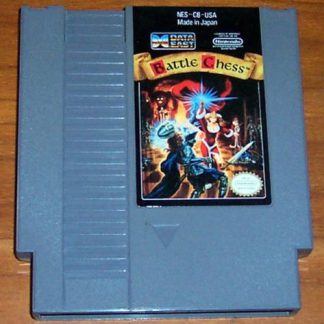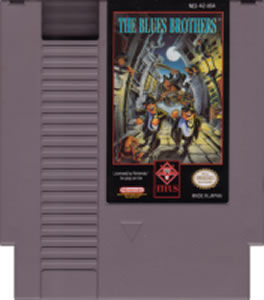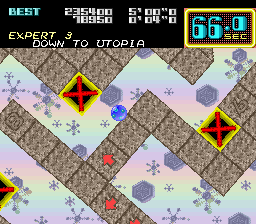
Sometimes it’s the most unlikely concepts that hook you. It happened with Tetris; sure you can obviously see why it was so addicting but back in the 80’s no one thought simply completing lines with geometric shapes could take over the world. Along the same lines Taito’s Cameltry allowed you to manipulate a marble by rotating the arena and has that same “just one more try” factor.
Released in arcades in 1989 and ported to the SNES in 1992 as On the Ball there is no story. You are simply an off screen avatar who influences the marble’s direction by rotating the playing field. It’s simple in concept but brilliantly executed and a perfect fit for the SNES’s Mode 7 capability. I would ponder why it isn’t more popular but it’s not as if most puzzle games outside of Tetris get any recognition. Regardless this is an excellent puzzle/whatever label you want to use with more than enough content to keep you occupied for hours.
The first concept you need to adjust to is the controls. You don’t directly control the ball but your actions do. By rotating the playing area left or right you can change its path as it rolls and falls. Gravity and inertia are taken into consideration as you move along and are perfectly modeled. You do have some direct control; tapping will make it jump while holding down a button will make it fall faster. With some skillful manipulation you can build up momentum by avoiding walls and other obstacles to fall even faster, a technique that becomes crucial in the later rounds. The early stages of the game will allow you to test these mechanics but it soon ramps up in short order.
Probably the single biggest factor in why On the Ball is so fun would be the levels. It isn’t long before new obstacles are introduced, such as blocks that need to be crushed to progress and speed curves that accelerate you unexpectedly. There’s a nice sense of progression in terms of what a given level will ask of you in terms of technique. As more and more obstacles are thrown in your path the skills you’ve built up in the earlier stages will come play in to play to help shave seconds off your completion time. The biggest hurdle to avoid would be the blocks that penalize you by removing time from the clock. Yes, time. This isn’t a big gay hippie circle jerk, time is of the essence. Any time left at the end of each round is added to the following stage and in short order it becomes mandatory to finish with enough time built up to cover your screw ups. Which you will. Many times in fact. But it’s the good kind of failure, where you can see what you did wrong and how to correct it. It says a lot about the game’s concept that playing with its physics is so damn fun.
If there is one failing it’s that it does become tedious after awhile and the game is short. That point will take some time to reach but it is inevitable. I can praise Taito for spicing up the simple gameplay but at 40 or so levels only the most dedicated will stick around to that point. 40 levels sounds like a lot however each lasts 1-3 minutes most, meaning with a little perseverance you can blow through all of the content in a few hours. The one thing that could have raised On the Ball’s status would have been a real multiplayer mode. The 2-player option is alternating rather than competitive which frankly sucks.
Simple in concept but brilliant in execution I’m almost certain most will love On the Ball. The SNES game is pretty cheap however there are perfect ports on the Wii’s virtual console and the Taito Legends series of games on various platforms. No matter what version you play you are in for a good few hours of entertainment.

![On the Ball (U) [!]002](http://www.retrogameage.com/retrogameage/wp-content/uploads/2012/06/On-the-Ball-U-002-150x150.png)
![On the Ball (U) [!]004](http://www.retrogameage.com/retrogameage/wp-content/uploads/2012/06/On-the-Ball-U-004-150x150.png)
![On the Ball (U) [!]026](http://www.retrogameage.com/retrogameage/wp-content/uploads/2012/06/On-the-Ball-U-026-150x150.png)
![On the Ball (U) [!]009](http://www.retrogameage.com/retrogameage/wp-content/uploads/2012/06/On-the-Ball-U-009-150x150.png)
![On the Ball (U) [!]052](http://www.retrogameage.com/retrogameage/wp-content/uploads/2012/06/On-the-Ball-U-052-150x150.png)
![On the Ball (U) [!]083](http://www.retrogameage.com/retrogameage/wp-content/uploads/2012/06/On-the-Ball-U-083-150x150.png)
![On the Ball (U) [!]041](http://www.retrogameage.com/retrogameage/wp-content/uploads/2012/06/On-the-Ball-U-041-150x150.png)
![On the Ball (U) [!]070](http://www.retrogameage.com/retrogameage/wp-content/uploads/2012/06/On-the-Ball-U-070-150x150.png)

